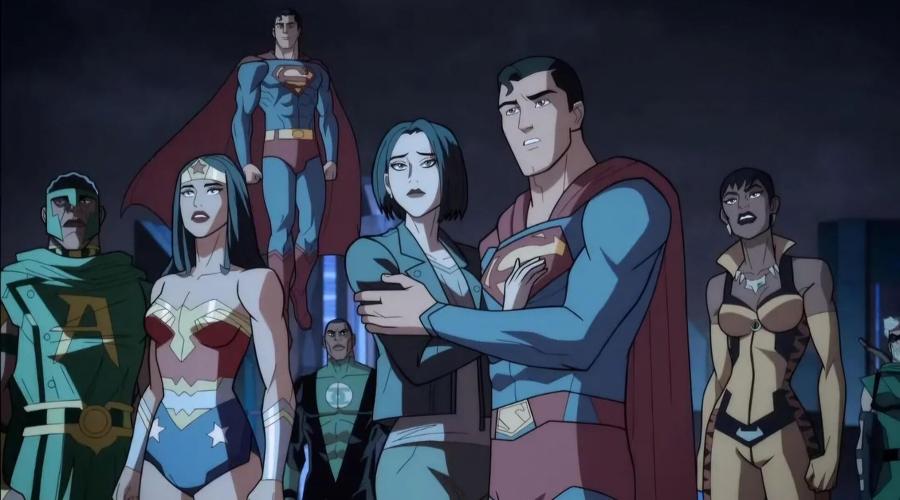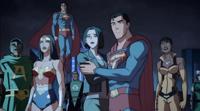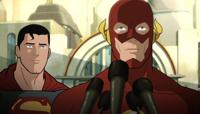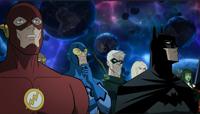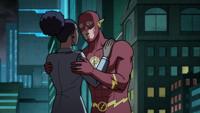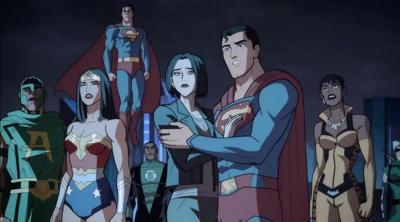Given that Deadpool & Wolverine (2024) is blowing up the box office and is set to be the biggest film of the year, it's a good idea to explore another property that is doing a lot of the same stuff. The DC Animated Universe or DCAU began over 30 years ago with Batman: The Animated Series (1992), which probably still stands as its most successful series. It even spawned a film called Batman: Mask of the Phantasm (1993), which remains the only DCAU feature to be released into theaters. It made Kevin Conroy, the voice of Batman in that series, one of the most iconic voices in animation. The DCAU has since had various features with various people playing Batman with various differences. In some features, Batman works as a lone vigilante. In other features, he has a ward named Robin. In others, he has a son and members that form a whole Bat-family. In some features, Conroy plays the voice. In others, you have Jason O'Mara or Jensen Ackles. It's the same Batman but slightly altered, or they're all Batman but simply existing in slightly different universes, which is representative of DC Comics throughout the decades.
DC Comics released Crisis on Infinite Earths (1985), a comic book series that was meant to get rid of all these different universes aka the "multiverse." Allegedly, readers didn't like the multiverse, so this nearly 40-year-old comic book was meant to unify all the various universes into one. A live-action adaptation on the CW was released back in 2019, but that television show didn't have the ability to pull off what these animated features can accomplish. These features are therefore a proper adaptation. The plot is basically a very powerful being is literally trying to destroy the Earth in every single universe, which are hundreds, if not thousands of Earths or more. Without spoiling it, this plot is pretty much the exact same plot of Deadpool & Wolverine.

This series though tells its story in three parts. I've only seen Part One and Part Two. I've seen clips of Part Three but not the whole thing. However, I can probably say definitively that Part One is the best episode of all three. Each part involves a boat load of characters, many of the Justice League members, but each one has focused on one particular member. Part One focuses on Barry Allen aka The Flash. Part Two focuses on Kara Zor-El aka Supergirl. From what I've gathered, Part Three focuses on John Constantine, but it's been reported to be more all over the place than the previous two. The only redeeming aspect of Part Three seems to be the return and indeed final vocal performance of Kevin Conroy.
Matt Bomer (The Normal Heart and Magic Mike) voices Barry Allen aka The Flash, a blonde hunk, a quip-filled jock who is also a scientist, a forensic chemist, according to the comics. One day he meets Iris West, a Black waitress who is an aspiring reporter. Obviously, as The Flash, Barry is the fastest man alive. He can run faster than the speed of sound and really faster than the speed of light. It seem as if this ability allows him to travel through time, which is exactly what's happening in Part One. This episode is told in a non-linear fashion where Barry is basically running to different times throughout his life. He even travels back to witness the formation of the Justice League by Batman, aka Bruce Wayne, voiced initially by Jensen Ackles.

One crucial moment that Barry visits is the time that the Justice League fought a villain called Amazo, which is an android built by a scientist named Dr. Anthony Ivo. Unfortunately, Lex Luther, the recurring villain for Superman, took control and manipulated Ivo's android in order to kill Superman. Amazo has the ability to copy the powers of the Justice League members in order to use their powers against them. The Justice League has to fight Amazo and figure out how to overcome him. While this battle is occurring, Barry is traveling to other time periods, including into the future.
Eventually, Barry discovers that in the future, an anti-matter wave is heading for the Earth and will destroy it, but this is after it has already destroyed the Earth in other universes. The threat feels like this huge, unstoppable force and it seems as if no one in the Justice League can stop the anti-matter wave. Barry seems to be only a witness to this destruction and downfall of everything. How this feature deals with this threat from Barry's point-of-view is actually clever and powerful. It represents probably the most clever and affecting thing I've seen in a superhero movie ever.

There are things that are set up for Part Two and Part Three, but it doesn't matter. The story here of what The Flash experiences is engaging enough to overlook those other things. It's also more engaging than anything that happens in Part Two and likely Part Three. It becomes clear that Part Two is focusing on Supergirl, but it doesn't focus on her in the same way that Part One focuses on The Flash. In fact, Supergirl is sidelined in Part Two in order to setup a lot of other things including the Psycho Pirate aka Charles Halstead and the Monitor, as well as the man revealed to be John Constantine. As such, Part Two feels more all over the place and messier.
Rated PG-13 for some violence and brief strong language.
Running Time: 1 hr. and 33 mins. (Part One)
Rated PG-13 for violence, some disturbing images and thematic elements.
Running Time: 1 hr. and 34 mins. (Part Two)
Available on Max and VOD.


